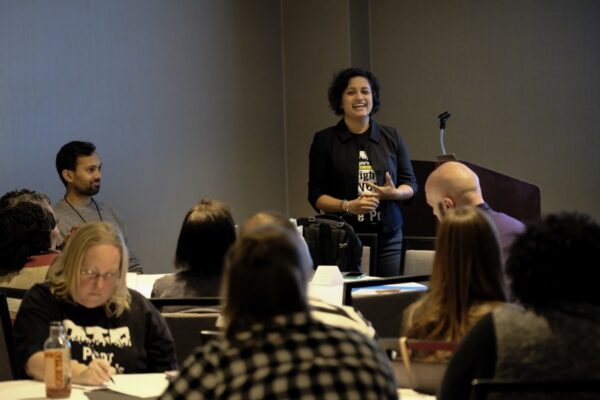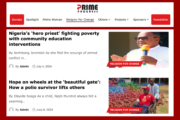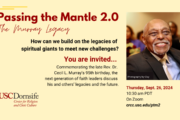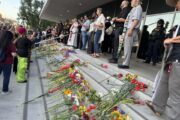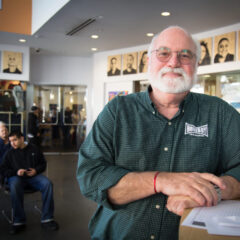This radio documentary was produced by KALW’s The Spiritual Edge, with the support of CRCC’s global project on engaged spirituality. Listen to it on The Spiritual Edge’s website.
To hear this and other profiles, subscribe to The Spiritual Edge podcast in your favorite podcasting app, including Apple podcasts, Spotify or Google Podcasts. Find out more on The Spiritual Edge website.
It’s a Friday night at the First Baptist Church in Selma, Alabama. As the wooden pews fill up, latecomers tuck coats and handbags onto the floor beside them. Up front, an organizer adjusts microphones and introduces the next speaker, Shailly Gupta Barnes. The crowd is here for a 2018 panel discussion sponsored by the Poor People’s Campaign, a national anti-poverty organization. Forty-three-year-old Shailly rises to the pulpit, dressed simply in a long black tunic and loose white pants. Her silver earrings clink as she greets the crowd.
Shailly reminds listeners of the water crisis in Flint, Michigan, which began when the city’s unelected emergency manager switched its water source — without adequate testing or treatment. The corrosive water leached lead from aging pipes and delivered it to every tap and faucet. As a result, Shailly says, an entire city was poisoned. Applause and shouts of agreement echo through the church.
Shailly is the campaign’s resident policy wonk. Her work — distilling data on present-day poverty — begins at gatherings in church basements, temples and classrooms, listening to poor people. Then she combs through transcripts from these meetings, looking for common threads.
She explains that water was an issue in Alabama, where people lacked sanitation. It was an issue in Michigan, where people’s water was shut off. It was an issue in Standing Rock, where indigenous communities were fighting to protect their water against pipelines. It was coming up in California. “What,” she asks, “is happening around water in this country?”
Once she’s identified a key issue, she digs deeper: reading economic reports and consulting with experts. These elements — personal testimony and academic research — shape the policy agenda of the Poor People’s Campaign.
Its larger goal is to change how we in the land of the American Dream think and talk about poverty. Whether we mean to or not, most of us internalize the idea that being poor means you screwed up. Shailly says that there’s a strong cultural narrative that frames poor people as “people who aren’t working hard enough, people who have the wrong values, people who don’t know how to save, they’re not educated, they’re lazy, they’re crazy…”
These narratives, Shailly says, don’t just divide poor people from wealthy people. They divide poor people from one another. Even if you are poor, she argues, “you’re still going to say, ‘but I work hard, so I just have to work harder. I’m not actually poor. You know, I have student debt, credit card debt. I’m not sure if I’m going to make my rent this month — but I’m not poor because I know what I should be doing, I’m just not doing it well enough.’”
In fact, a lot of Americans are poor. Over 140 million are either poor or low income, according to the federal Supplemental Poverty Measure. That’s almost 44% of the US population. Shailly says the campaign focuses on “breaking the isolation of people who think that this is just them, it’s just their fault, it’s just my problem — moving from that position of self-blame to actually making a social claim on our government and on society to make what we need possible.”
To grow the movement, today’s Poor People’s Campaign builds on a history that many Americans have forgotten — or never learned. In 1968, Martin Luther King Jr. and other activists launched an earlier Poor People’s Campaign, an organizing effort that connected civil rights to economic justice. They urged the federal government to guarantee the right to a meaningful job at a living wage. To build support, Dr. King barnstormed the South, promoting what he called an economic bill of rights. He called on supporters to come to Washington, “even if you have to bring your whole family.”
Thousands answered that call. They arrived by bus, by car, by mule. To demonstrate their commitment to stay until the government met that demand, campaigners built 3,000 wooden huts on the National Mall. They named the encampment “Resurrection City.” By night, the inhabitants connected with their new neighbors. Mexican-American organizers mixed it up with tenant farmers from Mississippi and teenagers from Appalachia. By day, they lobbied policy makers throughout DC. One participant from Louisiana described plans to lobby Senator Russell Long, noting that “he may not want to hear us, as he keeps hollering ‘law and order.’ “But,” she continued, “when the hell is justice?”
Events beyond its control clouded the vision of the Poor People’s Campaign. An assassin killed King in April 1968 and another took down presidential candidate Bobby Kennedy two months later. The escalating war in Vietnam drained political will and money from the federal War on Poverty. By summer, police in riot gear demolished Resurrection City.
Shailly emphasizes that she did not know “anything” about the Poor People’s Campaign until she was in her 30s. She grew up with the textbook I-have-a-dream MLK: the reformer, not the revolutionary. “For most of my childhood and early adult years,” she acknowledges, “my life was pretty apolitical. I just kind of moved through these hoops.”
She grew up in a tight-knight Indian immigrant community in the Chicago suburbs, and spent her childhood playing in friends’ backyards and tearing around the neighborhood with her sister. A constant was the local Hindu temple her parents helped establish. Shailly spent time there soaking up the aromas of lemon and tamarind rice.
In religious education classes, she studied Hindu texts like the Bhagavad Gita. Her parents and religious teachers emphasized two ideas: dedication and detachment. Dedication is digging in. Shailly says dedication means recognizing that “injustice exists in the world” and that “we have a responsibility to engage with it and try to do something about it.” Detachment is letting go, acknowledging that “there are limits to what we can do.”
These were not abstract ideas in the Gupta household. Shailly remembers stressing about a biology exam in high school. Her dad counseled detachment. “He actually offered a lesson from the Gita,” Shailly explains. “And what he said was, you’ve been working hard, and studying for this exam. You’ve done that work. And now, now you just have to take it and — what he said was ‘be detached from the results.’ Whatever happens, you’ve done your share, and now things are a little bit out of your hands.”
All this made sense to Shailly. Do what you can do, and let go of the rest. She kept leaping through those hoops: An economics degree from the University of Chicago, law school at UCLA, then a job at a top-shelf firm in southern California. A couple years in, she worked with one of the partners on a big entertainment law case. They won a major victory. Shailly recalls, “He turned to me — I was a young lawyer, I was 25 years old — and he goes “I love it when the wheels of justice turn the wrong way.” And he was talking about a victory we had! And all of a sudden I had to stop and think: what was I doing?”
Her partner, Adam Barnes, was asking similar questions. After months and many conversations, they decided to try a different path. With a laugh, Adam recalls that Shailly “walked into her boss’s office and told her that she was quitting her job and joining the Peace Corps.”
Shailly and Adam were posted to Niger, the largest country in West Africa. They arrived in the capital in 2004, in their mid-twenties and newly married. After a month of training, a colleague dropped them off in their new home, the rural farming village of Kokitamu. Their job was to rehabilitate the village’s exhausted soil, digging holes to catch rainwater that would nourish crops. To their new neighbors, it seemed like a fool’s errand. Adam thought often of what a Peace Corps colleague had told him. “It’s like coming into a place,” he mused, “standing on a corner with a sandwich board, naked, saying ‘I’m here to help.’”
In their first year, Shailly and Adam muddled through conversation in Zarma, the local language. By year two, they had gotten to know the local Sufi Muslim leader, the region’s sheikh. After a good harvest, farmers brought their excess crops to his granary. In a lean season, hungry families asked him for food. Every time, he said yes. “Grains do not last past a certain time,” Shailly explains. “So they were not meant to be hoarded. They were meant to be redistributed to anyone who needed them, whenever they were required.”
That system made an impression on Shailly and Adam. It seemed to require the community’s leaders to redirect wealth toward those who most needed it. “They described it as their baraka or their blessing,” Shailly says. “It’s almost what I would in Hinduism compare it to dharma, or duty. Because they were in that leadership position, their duty was to improve the conditions of the people. And I remember asking, you know, well, what if you don’t? And the response from the religious leadership was, then the community will remove us. The community will see that we are not the leaders that they need.”
As their Peace Corps contracts wound down, the sheikh’s granaries stayed with them. Was there a way to bring that commitment back home to the US?
For Adam, studying religion was the next step. In 2006, when the couple returned to the US, he enrolled at Union Theological Seminary in New York City. As Adam learned more about the progressive Protesant tradition, Shailly revisited her own Hinduism. Shailly remembers, “That’s when I returned to some of the things I had grown up with and started to wonder, how does detachment work when you’re in constant struggle? How do you make sense of that?”
After Niger, “detachment” seemed…fatalistic. Like a call to accept injustice and suffering. Yet returning to the texts she’d studied as a kid yielded a revelation. “The biggest lesson that I came out with by revisiting those texts,” Shailly says, “was that God takes a position against injustice. God is not neutral.” Then she noticed another detail in what her father had told her when she was in high school. He had emphasized “recognizing that you alone cannot change everything.” It’s not that you can’t build a better world, Shailly thought. It’s that you can’t do it all by yourself. Shailly says the notion of detachment “asks us to keep that egotism in check and put ourselves in relationship with other forces and other people.” In other words, the flip side of detachment might just be solidarity.
In 2009, anti-poverty organizers at Shailly’s husband’s seminary launched a new Leadership School. Over a hundred leaders, mostly poor people, would gather to share ideas and strategize in the West Virginia woods. The organizers asked Shailly if she’d come along, too. It was just a year into the Great Recession. “A lot of people were still reeling from that crisis,” she recalls. “The massive housing insecurity and the job loss and all of that was still kind of spiraling out — and I had no, no idea how bad things were.”
Despite her brush with poverty in Niger, Shailly felt insulated. She came from an upper-middle class family. She was a lawyer with two graduate degrees. She realized she had plenty still to learn. “I had never been in a space like that before,” she says. “Our discussion of economics, our discussion of history, our discussion of how poverty was legal: all of their insights just broke through my understanding of the world at that time, made me revisit everything I thought I knew. And once that happened, I really couldn’t turn back.”
At first, she worried that her own background might position her as an outsider. With time, that fear faded. “It is an ongoing conversation I have with myself sometimes,” Shailly explains. “And in the past few years, I’ve stopped having it — in part because I’ve reconciled to myself that this is my life commitment. And so for whatever reason, karma, dharma, whatever it is, this is the position I find myself in. All of my life’s experiences have brought me to this point.” Before long, Shailly started working full-time for the group that had organized the West Virginia gathering. Today, it’s called the Kairos Center for Religions, Rights, and Social Justice. It’s a core member of the Poor People’s Campaign.
A few years ago, the Kairos Center decided to do an “audit” of poverty in the US. Rev. Liz Theoharis, co-chair of the present-day Poor People’s Campaign, explains: “We asked Shailly to head up that process, looking over the past fifty years: where things had been when Dr. King and the welfare rights leaders and others had called for a Poor People’s Campaign in ‘67 and ‘68 — and where they were in 2017, 2018, fifty years later.”
Shailly pulled together a hundred and twenty page report called ‘The Souls of Poor Folk.’ “Over those 50 years,” she says, “all of the injustices that King was calling out — whether it was around voting rights, the racial wealth gap, job insecurity, housing security — all of these things have worsened.” To change this trajectory, the Campaign developed a set of policy demands tailored to 2018. Leaders worked to build support through mass meetings, marches, and music. Then the pandemic arrived, changing the shape and sound of solidarity. No more packed meeting rooms, no more singing in poorly-ventilated church basements.
The Campaign had planned a March on Washington for June 2020. That March moved online due to Covid. Two and a half million people watched via livestream. Participants testified on a webcam, forming a montage of faces in squares. A Wisconsin woman in a multicolored sweater introduced herself: “I’m Natalia Farjado and four weeks ago I was okay. Until this pandemic hit. All of a sudden the chocolate factory I work for closed, so I’m out of work…” An older couple in Florida leaned toward the camera, photos of their son blurry on the wall behind them. “We have been on a complete roller coaster ever since Anthony has been incarcerated,” the woman explains. “Anthony is a paraplegic, forty-year old Black man who was shot in the back at age 20.” A young man in a dress shirt and red tie recalls his childhood: “I grew up around mountaintop removal sites, natural gas, hydraulic fracturing. The water that ran into our house that we bathed in, we couldn’t drink.”
By the end of the virtual March, three hundred thousand participants had sent letters to their elected representatives, pressing for Campaign priorities like rent relief and a $15 federal minimum wage. Co-Chair Rev. Liz Theoharis says the pandemic has pushed more Americans to recognize what its organizers have talked about for years. “If somebody doesn’t have health care,” she emphasizes, “it means that everybody’s health is in jeopardy. If somebody doesn’t have a place to stay and is homeless, then then staying in place and social distancing isn’t really possible.”
Through the summer of 2020, Shailly kept busy writing a stinging report on the federal CARES Act. That pandemic relief measure, she wrote, provides wealthy Americans with a “comprehensive welfare program,” while offering the poor only “piecemeal and haphazard relief.” Her analysis draws on Martin Luther King Jr’s thinking, who wrote that the prescription for the cure rests on an accurate diagnosis of the disease. “There was never an accurate diagnosis of either the pandemic or the economic impacts of the pandemic,” Shailly says. “Who was most affected, in what ways and then how to deal with that. And so, months out from it now, we’ve seen billionaires increase their wealth by over a trillion dollars.” At the same time, the pandemic has slammed low income families. They’re more likely than middle class families to have lost jobs and to struggle to pay for food, rent, and medical bills.
To change that, she wants bold action. She has a long list of ideas: “Debt relief, not just saying ‘you’re not going to be evicted, if you don’t pay your rent,’ but actually just canceling that rent. Expansion of social welfare programs in terms of food security, housing security, income security. Offering regular guaranteed payments to people in a regular way — not just a one-time stimulus but recurring payments. We would need a massive expansion of good jobs, expanding public health, addressing the climate crisis. All of these things are possible.”
Wishing won’t make all this happen, she says. That’s where the broader work of the Poor People’s Campaign comes in — getting people from different regions, ethnic backgrounds, education levels to talk and strategize. To realize they’re fighting the same fight. Shailly notes, “There are 140 million people who are poor or one emergency away from being poor. And of those 140 million, 66 million are white and 74 million are people of color. Unless these people actually come together, we’re not going to be able to fight for these really big solutions. We’re going to get these piecemeal band-aids that will save some of us for a little bit — but they’re not the solutions that are going to fundamentally change the direction of where we’re heading.” That means pressuring elected officials, from the city council member to the president to the Democratic majority in the Senate. It’s the next phase of a long fight.
Shailly recalls the Bhagavad Gita, the story her dad emphasized when he tried to explain detachment. In the midst of a battle, its central figure, Arjun, is a warrior who’s not so sure he wants to keep fighting. Most of the Gita consists of Arjun’s conversations with the god Krishna, who counsels him. In no uncertain terms, Krishna tells Arjun: keep fighting. “That’s what I think gets lost in a reading of the Gita that doesn’t actually put it in the context of a war,” she says. “Krishna is making all of these arguments, not so Arjun, you know, retreats to his home and pulls himself out of the world. But Krishna offers him this advice to get Arjun to pick up his bow again, and to go back into battle.”
Yes, in the end, whatever happens…happens. In the meantime, Shailly says, she’ll keep fighting.
Click here to listen to the radio documentary on SpiritualEdge.org.
Jess Engebretson is a journalist fellow with the Spiritual Exemplars Project.
